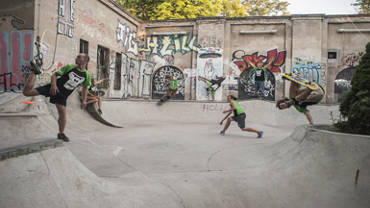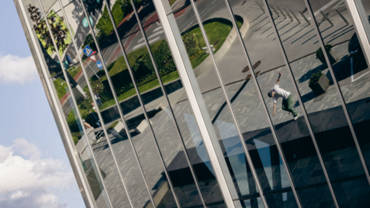Start playfully
So what do you need to consider if you want to get the little ones cruising skilfully and safely on four wheels? And what's the best way for kids to learn tricks? Kids can playfully roll on a board, even the youngest ones. Whether sitting, kneeling or standing, with or without stopping – familiarising yourself with the board at the beginning is the be-all and end-all.

Suitable equipment
Helmets and protectors
As with many sports, the right, age-appropriate equipment is important. But before we get to the right boards, let's start by saying that falls are part of the game and skateboarding is not for kids who are perhaps still too young for it - parents and, if necessary, sports physicians are the best judge of that.
Knees can quickly be scraped, elbows bruised, and if you do fall on your head, it can end badly without a helmet. That's why it's essential to get your first experience on a board with a helmet, and knee pads are also a good idea on flat surfaces and small ramps.
Elbow and wrist pads complete the equipment. To be honest, it should be mentioned that protectors can also restrict mobility, so it is very individual how much protection really makes sense for each skate session.

Skateboards for children
A lot has been achieved in recent years with complete boards specially developed for children. Up to the age of about ten, the smaller versions really make sense because the trucks turn more easily and the short, narrow decks are easier to manoeuvre. In addition, the griptapes are often made of materials such as cork so that kids don't get annoying abrasions on the rough surfaces that are common on skateboards for adults.
There are now skate courses for kids in many cities and parks, as well as camps and equipment hire. Learning new tricks in a group is also often an additional motivation when skateboarding. Especially when kids of the same age are together, a lot of progress can be made and the kids push each other.
However, slightly older kids can also switch to normal set-ups. Especially when they have already made significant progress, wider boards help them to land tricks more easily and safely.
Behaviour in the skate park
It is very important for beginners to follow the unwritten rules:
- Do not sit on ramps
- Do not stand/practise on the run-up to elements.
- Curbs, rails and park elements are not places to leave backpacks, bikes, scooters, etc.
It also makes sense at the beginning to observe how and from which starting point certain ramps are approached, and which lines result. These areas are usually very busy. Especially in parks that are relatively crowded or when the other skateboarders are at a high level, it is often difficult to find suitable spots to try out new things in peace. It definitely makes sense to choose times when the kids can skate undisturbed.
Be careful on skate ramps
Similar to etiquette in the park, there are also a few things to bear in mind on the ramps. Especially at the beginning, you underestimate how far a grind or slide will go – and suddenly you're in the way. Normally you ride until you get off or if a trick doesn't work – then it's the next person's turn. It is absolutely essential not to ride into it when someone is skating on a ramp. This is often difficult for young kids to understand, but everyone has more fun in the skate park if an order is maintained.

The first "steps"
Foot position
At the beginning, it really makes sense to only ride the skateboard, because rolling along without doing tricks is a basis for the skills later on. The correct foot position is essential: the back foot is at cross-angles to the board at the tail, the front foot stands more or less parallel to it (above or just behind the front trucks). During various movements – including dives or tricks – it is mainly the front foot that moves. This foot turns slightly in the direction of motion or is offset. The parallel position is important in order to optimise balance and land tricks safely.
In board sports language, there are specific terms for the different foot positions, here are the two most important ones:
- Regular means that the left foot is positioned in front.
- Goofy is the position where the right foot is in front.
In comparison to other board sports, the foot position is less important in skateboarding at the beginning because it can be changed at any time. Over time, kids intuitively get a feel for their optimum foot position.
Making progress with the board
Pushing
Pushing, in other words starting to ride with the back (!) foot, is unfamiliar at the beginning and often a challenge in terms of coordination. Skateboarding doesn't work without it, so it needs to be learnt.
Keeping your balance
The more the kids ride, the easier it becomes to keep their balance. Above all, being able to turn precisely is a basic requirement for being really versatile and safe in parks and especially bowls. Good skateboarders always have an overview of what's going on around them, can take evasive action and react spontaneously when it comes to tricks and lines.
Pumping
...in ramps, over elements or on pump tracks is also part of the basic repertoire, which children can also try out pretty easily and will soon realise how they can accelerate their board by kneeling down. The same applies here: The more often they do it, the easier it becomes.
Tic Tac
...is the name given to the technique that creates momentum without getting off the board. How does it work? Lift the front axle, turn approx. 45 degrees to the right or left, put it down again and repeat the same in the other direction – a little practice is required here. The Tic Tac moves help you to get going or speed up, but they can also often be used to compensate for tricks that have been landed incorrectly.
Tricks for advanced riders
Once the kids are a little more confident on the board, they can actually start slowly trying out their first tricks. For example, riding wheelies - i.e. riding only on the rear wheels - as a precursor to the ollie, which means jumping with the board. Wheelies can also be used to drop off small pavement edges or similar by shifting the weight onto the tail and thus taking the weight off the nose.
And then it's on to ollies...but more on that in our detailed Skate Beginner's Guide. For plenty of information and know-how about skateboarding as well as assembling, repairing and maintaining skateboards, visit our Skateboard Buyer's Guide. Our Customer Service team will also be happy to help you with product questions.






